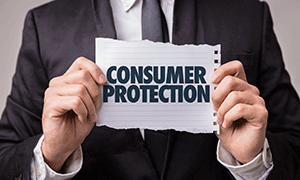For more than six years, the Consumer Finance Protection Bureau (CFPB) has been collecting and responding to consumer complaints about the nation’s collection processes. The data gathered reveals how America’s banking, lending, and collection agencies engage with everyday consumers. In return, the reports give the CFPB critical insight to effectively oversee how the country manages its financial resources. Each report summarizes the most-recent findings and complaints of the month.
In a rush? Check out our newest infographic for a quick overview and key points from the CFPB July report.
Collecting Consumer Responses
The consumer finance response division of the CFPB receives daily phone calls, emails and physical letters that describe existing issues between collectors and those owing on a debt. Consumers can report an issue and ask for assistance in reaching a resolution. The CFPB will establish a case for the consumer and begin the inquiry process. Acting quickly – usually within one day – the consumer finance response division contacts the company in question for a response to the allegations. Data shows that most companies respond quickly to CFPB inquiries – usually within 15 days. Once the facts have been disseminated (often, miscommunications or errors cause inappropriate activities), the CFPB will help the consumer and the collector to resolve their differences.
Disgruntled consumers can also find answers to their questions about the legality of collection practices by accessing the CFPB’s consumer resources center. The center offers guides and information on virtually any type of collection process and provides the data in over 180 languages, as well as for those with hearing or speech challenges.
What Consumers Complain About
The CFPB receives more than 25,000 complaints each month. It has handled more than 1,242,000 claims since it opened its doors in 2011. Of those complaints, a large percentage are related to collections activities, which accounted for 30 percent of all claims (87,927) in 2016. This number was down from 35 percent (88,277) in 2014.
Credit collection practices generated 20 percent of all complaints in 2016 – second only to credit reporting. The CFPB received 53,923 complaints about inappropriate data showing up on consumer credit reports. In 2014, that number was just 44,663 complaints (18 percent). Among other complaints reported were: inappropriate collection activities associated with home mortgages; bank accounts; credit cards; consumer, payday and student loans; prepaid products; and money transfers.
How Companies Respond to Consumer Finance Complaints
Remarkably, companies responded in a timely fashion – approximately 97 percent of the time – indicating their willingness to discuss the issue. As always, there are two sides to every story, and it is often that the companies can demonstrate that they’ve been appropriate in their attempts to recover a debt.
After gathering the necessary information and finding a solution, the CFPB closes the case by defining the method of its resolution. In cases where refunds or other financial transactions settle the matter, the CFPB marks those as “closed with monetary relief.” In cases where the removal of inappropriate information is called for, the case closes as “closed with non-monetary relief” or “with explanation.”
What the Numbers Say
The data collected in the CFPB Monthly Complaint Report reveals which subsectors of the industry are most (and least) responsive to consumer finance complaints. Some industries are exceptional in their timely response, cooperation, and engagement with the CFPB. Topping the list of most responsive subsectors is credit reporting companies (less than 1 percent failed to respond on time), credit card companies (1 percent), and student loan companies (also 1 percent).
On the opposite end of this “cooperation spectrum” is the payday loan industry, where one in 10 complaints (10 percent of the total) experienced longer waits for company responses. Seven percent of debt collections agencies also dragged their feet when responding to CFPB inquiries.
Overall, the responses from consumers about the efforts of the CFPB been positive. Borrowers welcome the security that big brother CFPB provides by keeping a watchful eye over the nation’s debt collection processes.











